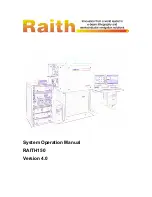
4.
OPeRATING INsTRucTIONs
4.2 Analysing engine Mechanical condition via Manifold
vacuum Readings
The gauge readings shown on the right hand side of this page are only
examples of what may be observed. It is important to remember that it is
the action of the needle rather than the actual reading that is more
important. Varying engine types will run different manifold vacuum
pressures, depending on camshaft profile, valve overlap, timing etc, so an
exact vacuum reading cannot be specified. The main criteria is that the
needle reading is between 16 to 21inHg and steady. manifold vacuum is
also affected by altitude and it will drop approximately 1inHg for every
1000 feet above sea level so this must also be considered when
assessing manifold vacuum actual readings.
step 1.
run engine until normal operating temperature is reached. Switch
engine off.
step 2.
Locate and connect the vacuum gauge to a port directly on the
manifold (fig.3) or on the carburettor/throttle body below the throttle
butterfly.
step 3.
Start and run the engine at idle, observing the gauge reading.
refer to the gauge examples on the right of this page to indicate any
problems and their possible causes.
4.1
This hand pump and its adaptors can be used to test vacuum motors and
control valves as well vacuum or pressure operated systems and
components that require to be properly sealed. The pump and its
associated accessories can also be used to bleed brakes. In pressure
testing mode the pump may be utilised to dispense or transfer liquids and
provide slight pressure during gravity or pressure bleeding.
The VS403.V2 can be used for both pressure and vacuum testing by
means of the sliding sleeve selector at the front end of the pump.
To select
PRessuRe TesTING
mode, move the sliding sleeve away
from the nozzle end of the pump until it makes contact with the main
body. See fig.1A above. The hole indicated at 'X' must be fully covered.
To select
vAcuuM TesTING
mode, move the sliding sleeve away
from the main body of the pump until it makes contact with the 'o' ring
just behind the nozzle. See fig.1B above. The hole indicated at 'X' must
be fully revealed.
fig.1
fig.3
(1) ReADING:
16 - 21inHG
DIAGNOsIs:
normAL
(2) ReADING:
When the throttle is
suddenly opened then released,
the needle should drop to below
5 inHg then bounce up to
approximately 25 inHg before
settling back to the original reading.
DIAGNOsIs:
normAL
(3) ReADING:
Extremely low but
steady
DIAGNOsIs:
Leaking intake manifold
system, Faulty manifold gasket or
carburettor base gasket, split vacuum
hose, seized open EGr valve.
(4) ReADING:
reading low but steady
DIAGNOsIs:
retarded ignition timing.
Confirm using timing light and reset to
manufacturer’s specification.
(5) ReADING:
reading slightly low
and fluctuating slowly.
DIAGNOsIs:
over lean or rich
mixture. Check and reset in
accordance with manufacturer’s
specification.
(6) ReADING:
regular fluctuation
between normal and low.
DIAGNOsIs:
Blown head gasket
between two adjacent cylinders. Carry
out cylinder leakage test.
(7) ReADING:
reading slightly lower
than normal including when throttle is
suddenly opened then released.
DIAGNOsIs:
Worn piston rings. Carry
out compression test.
(8) ReADING:
regular drop between
normal and low reading.
DIAGNOsIs:
Burnt valve.
(9) ReADING:
normal when first
started but drops rapidly when rPm
held at 3000.
DIAGNOsIs:
restriction in exhaust
system.
VS403.V2 Issue: 1 - 09/01/12
Original Language Version
fig.2























